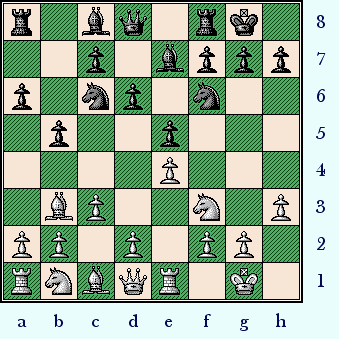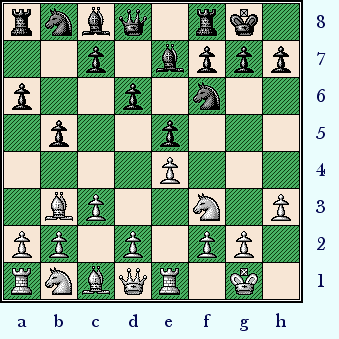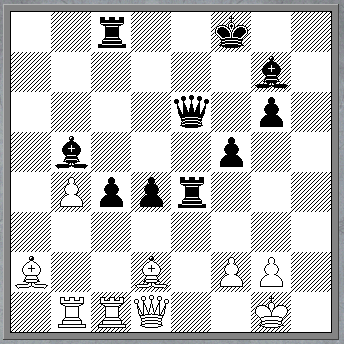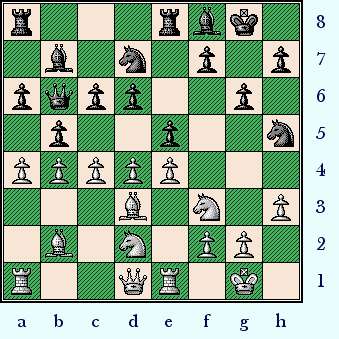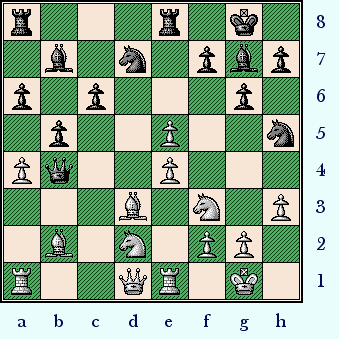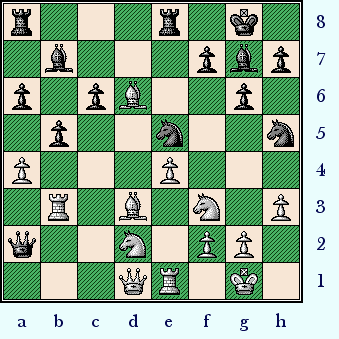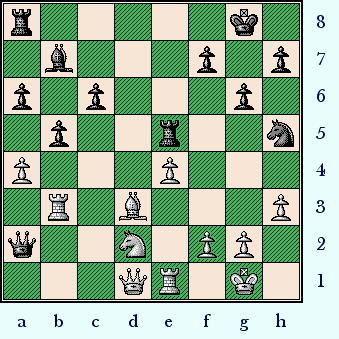GM Alexander Morozevich (2743) -
GM Krishnan Sasikiran (2666)
|
|
|
{The actual position on the chess board, after White plays 9.h3.}
************************************************
*** *** *** *** *** *** *** *** *** *** *** *** *** *** *** *** *** *** *** *** ***
Black now has many different
responses to White's last move;
each one initiates an entirely
different (sub) - system of the
Ruy Lopez!! (Tchigorin, Zaitzev,
Keres, etc.)
[ After the moves of:
9.d4!? Bg4; 10.Be3!?,
{Diagram?}
This is the move almost
universally recommended by
most opening books
in this
particular position.
( Also possible is: 10.d5!?, "=" {Diagram?}
which seems to be about
equal ... maybe, just
maybe
... White is a little better. )
10...exd4; 11.cxd4 Na5;
12.Bc2 c5; "~" {Diagram?}
White may have a TINY edge,
however I evaluate this position
as being somewhat unclear.
Haba - Foisor; ICT / Masters {open?} / Bad Worishofen, GER; 1992.
[ See MCO-14, page # 79;
columns four, (# 04); through column
five, (# 5);
and all applicable notes. ]
*** *** *** *** *** *** *** *** *** *** *** *** *** *** *** *** *** *** *** *** ***
See {also} the following clash:
GM Rustam Kasimdzhanov - GM Michael
Adams;
ICT/ FIDE World Championships
{A Knock-Out event.} (Game # 7)
Tripoli, Libya; / June 19th, 2004.
{This game was drawn after
some very wild and rather
strange adventures.}
I have deeply annotated ALL the
games of this match ... this e-book
is available
on my "downloads"
web-site,
now - at no charge!
(However, you MUST
have a
current ChessBase program ...
in
order to be able to read this file!!) ]
**************************************************************************
Black's next move looks almost
like a beginner's play ... ... ...
9...Nb8;
('!?')
{See
the diagram - - - just below here.}
This 'strategic retreat' is the
beginning of ... "The Breyer
System."
***************************************
|
|
***************************************
{Julius} Breyer was one of the members
of the "Hyper-Modern School."
(Although this is not technically a
real hyper-modern type of
opening, this school of thought
brought
new ideas to many of the
older opening lines.)
*******
The
main ideas
of this variation are:
A.)
Free Black's Queen-side
Pawn majority to advance; ('!!')
B.)
Clear the long diagonal for
possible use by the Black QB;
C.)
Re-position the Black
Knight on the d7-square ... where it is much more flexible,
(and also not unprotected!);
supports is 'brother' on f6, and
can even be rushed to
the
defense of the King - should
the situation on the chessboard
require it.
(In some lines, if
White should play the pawn
push of d4-d5, a BN on d7 can
also
utilize the handy c5-square.)
*********************
[ The older move here is:
9...Na5!?;
{Diagram?}
which leads to the lines of
... "The Tchigorin System."
{See any good reference book.}
[ See also MCO-14, beginning on page # 81. (All columns.) ] ]
We continue with the actual
game ... both sides continue to
travel a well-known main line.
10.d4,
(lever)
{Diagram?}
Note how this move is basically a
moral victory for White. The first
player has achieved
the objective
of dominating the center with
pawns.
*********************
[
A very interesting game was:
10.a4!? Bb7; 11.d3!?,
{Diagram?}
Much too slow a treatment to
be effective here.
( Better was: >/= 11.d4!; "~" )
11...Nbd7; 12.Bc2 Re8;
13.Nbd2 Bf8; 14.Nf1 c5; 15.Ng3 g6;
{Diagram?}
This is good - very solid
and sensible. (Fritz likes
...d6-d5; in this position,
I am
not sure if Black is
ready for this advance.)
16.Bg5 Qc7; 17.Nh2!?,
{Diagram?}
White has no time for such a
maneuver ... his first priority
should have been to
control
the center of the chess board.
( Better was: >/= 17.Qe2, "=" {Diagram?} or even the try, c3-c4!? here. )
Black now offers to (possibly) sacrifice a Pawn ... simply to allow his pieces more play.
(It is strange to see this idea
played in this game. I get the
eerie feeling that
Garry Kasparov
might have played the same
move in this particular position!!)
17...d5!; ('!!')
18.Qf3 Bg7; 19.h4?!,
{Diagram?}
This is too ambitious ... and
is not merited by the current
position.
( >/= 19.Ng4 Nxg4; "~" ("=/+") )
Black now gains space ... a
very important basic element
of chess. Meanwhile, the first
player continues on his merry
way ... with his ... "attack."
19...d4!;
{Diagram?}
This is good ... and several
annotators praised this move.
(Fritz likes this idea, but prefers
to play ...h6; and then ...d4.)
20.h5!? c4!; 21.Rac1!? Qb6;
22.axb5 axb5; 23.Bb1!?, (Maybe - '?!')
{Diag?}
This could be less than best,
but it is difficult to be sure.
( Maybe slightly better was: 23.h6!? Bf8; 24.Qe2!? dxc3!?;
25.bxc3 Ra3!; "=/+" (The a-file.)
(and) Black holds a small edge. )
Black continues to work on
the idea of holding extra
space ... and maybe just
trying to
smother White.
(It is fairly instructive how
Spassky just overwhelms
White on d3 and c3.)
23...Rac8; 24.Ba2!? Ba6!;
25.hxg6!? hxg6; 26.Red1 Nh7!?; 27.Bd2!?
Nc5!;
28.dxc4 bxc4; 29.cxd4 Nd3!;
30.Rb1?!, {Diagram?}
This is - again - too passive.
(White seems to be fiddling ... while Rome burns!)
** ** ** ** ** ** ** ** ** ** ** ** ** ** ** ** ** ** ** **
( It seems that White had to
try and play:
>/= 30.Rc3 Nb4; 31.Bb1 exd4;
"/+" {Diagram?}
but Black remains solidly better. )
** ** ** ** ** ** ** ** ** ** ** ** ** ** ** ** ** ** ** **
30...exd4; 31.Ng4 Ne5!?;
{Diagram?}
It is very nice to play only thirty
moves ... against a very
strong master ...
and have such a favorable position.
( Several different strong
programs, like Fritz, DJ,
CM9000 ...
all prefer to
play: (>/=)
= 31...Bb5!; "/+" {Diagram?}
with a big plus for Black. )
32.Nxe5 Rxe5; 33.Rdc1 Ng5;
34.Qg4!? Nxe4!; {Diagram?}
GM Andy Soltis calls this ...
"The final shot in the positional
struggle." He goes on to say,
"All that Black needs now to
win ... is a little King safety."
35.Nxe4 f5; 36.Qe2 Rxe4;
37.Qf1!? Qe6!; 38.b4 Bb5;
{Diagram?}
Black is probably winning here.
But now Qd3 was worth a try ...
39.Qd1?! Kf8!;
{Diagram?}
This wins ... playing the Black
Rook to the e2-square! ... was also decisive here.
*************************************************
(An analysis diagram, the position after 39...Kf8; in the quoted game.)
*************************************************
40.Qf3 d3; 41.Rc3!?,
{Diagram?}
This is equivalent to
resignation. No further comment is required.
( Or 41.Be3 Ra8; ("-/+") )
Now ...Ra8; might be best.
41...Qc6!?; 42.Ra1 Re2; 43.Qf4 Qf6!?;
44.Rd1, {Diagram?}
Stop squirming! [ (>/=) Bxc4 ]
( 44.Rac1 g5!; "-/+" - A. Soltis. )
44...Rxd2!; 45.Rxd2 Qxc3; 46.Qd6+ Kg8;
47.Rd1 Kh7; 48.Qh2+ Bh6;
49.Qd6 Re8; 50.Qc7+ Qg7; 51.Qc5 d2!;
("-/+) {Diagram?}
and ... WHITE RESIGNED.
(0-1)
"When White loses in a Ruy
Lopez, it is often due to a
tactical error or a dangerous
counter-attack. But rarely is
he so completely squashed
positionally ... as in this game!"
- Andrew Soltis
Borislav Milic
(YUG) -
(future)
GM Boris Spassky
(USSR);
The
(FIDE?) Student Olympiade /
Lyons, France; 1955.
{Many databases give this game
as being played in 1952.}
[ See the excellent book:
"The Best Chess Games of
Boris Spassky," by A. Soltis.
Copyright (c) 1973.
Published by David McKay.
(Of New York City, NY; USA.)
Library of Congress card catalog
number: # 72-95165 ]
** ** ** ** ** ** ** ** ** ** ** ** ** ** ** ** ** ** ** ** ** ** ** ** ** ** ** **
( Now if White takes the
Pawn on d2 ... he is quickly
mated.
For example:
51...d2!; 52.Rxd2?, {Ugh!}
{Diagram?}
This is a mistake ... the box
says Rf1 was forced here for
White.
(I would prefer to throw
in the towel before making
such a silly move as Rf1!)
( After the moves: 52.Qxb5 Re1+; 53.Rxe1 dxe1Q+;
("-/+") {D?}
Black is also winning. )
52...Re1+; 53.Kh2 Bf4+;
54.g3 Qh6+; ("-/+")
{Diagram?}
and mate - on h1 - next. )
]
******************************************************************************
******************************************************************************
Returning now to the actual
game that we are attempting to
analyze -- for this month.)
10...Nbd7;
11.Nbd2, {Diagram?}
As in just about all the variations of
the Ruy Lopez, White maneuvers
his QN to-d2-f1-g3, (or e3);
in
order to activate this piece. (Many
times this Knight is a useful
component if the first player
decides
to launch an all-out
King-side attack.)
[ The move of:
11.Bg5!?,
{Diagram?}
looks very playable to me
... but is generally thought
to be
ineffective by opening theory. ]
Now Black continues with his
development ... forcing White to
defend the e4-square.
11...Bb7;
12.Bc2 Re8; {Diagram?}
Here is another useful maneuver
for the second player in the Ruy
Lopez. Black plays ...Re8; to be
followed by ...Bf8. Then Black
has the option of ...g6; and ...Bg7;
re-deploying the KB to a much
more useful diagonal. (Another
point is that ...g7-g6; is often very
useful to Black, who wishes to
prevent White from sinking his
QN into the f5-square, via the
d2-f1-g3 route.)
13.a4!?,
(Q-side lever!)
{Diagram?}
White seeks to break down the
pawn structure on the Q-side,
and possibly open the a-file for
his QR.
This move also softens
up b5, making a hanging Pawn
on that square a problem that
Black must keep
constant watch
over.
The most often played move is Nf1.
Naturally - depending on what both
parties play here ...
play can often
transpose from one line to another.
**************
[ I think the main line here is the move Nf1.
For example:
13.Nf1 Bf8; 14.Ng3 g6;
{Diagram?}
Just in time to prevent White
from playing Nf5!
15.a4!?,
{Diagram?}
There's that move again!
( Possible was: 15.Bd2!? )
15...c5;
{Diagram?}
There are 739 games in the CB
database ... with this position!!
16.d5,
(block) {Diagram?}
This move attempts to make
the Black QB ineffective on
the b7-square.
( Or 16.dxc5!? dxc5!?; "~" )
16...c4; 17.Bg5 h6;
{Diagram?}
The end of the column here.
18.Be3 Nc5; 19.Qd2 h5!?;
{Diagram?}
Putting the King on h7 looks to
be a little better or saner here.
20.Bg5 Be7; 21.Ra3!?,
"+/=" {Diagram?}
And now White's move of Ra3 ...
"leaves White slightly better in a
complex, multifaceted position."
- GM Nick de Firmian (In MCO.)
GM Alexey Shirov (2710) -
GM Paul van der Sterren (2555);
ICT / Hoogoven's Masters (A) /
Wijk aan Zee, NED; 1998.
(A pretty long and interesting
contest ... that was drawn.)
{1/2 - 1/2; 61 moves.}
[ See MCO-14, page # 85; column # 19, and also note # (f.) ]
**********************************************************
For a model attacking game, (from
this particular position); see:
GM Michael Adams -
GM Giorgi Giorgadze;
FIDE World Championships
(knock-out) /
Groningen, NED; 1997. ]
**************
Black's next move clears the
e-file for his Rook, and strengthens
his grip on the e5-square.
13...Bf8;
(re-deploy)
{Diagram?}
This is an extremely common
Ruy Lopez maneuver.
(Very often
this piece is ... "reborn" ... on the
long diagonal, and finds new vistas
to gaze at.)
[ Possibly better was:
>/= 13...c5!?,
('!') {Diagram?}
with good play for Black. ("=")
]
14.Bd3,
('!?' or '!')
{Diagram?}
Placing the Bishop on a slightly
better square here - and also
attacking the b5-square.
(I told
you to watch out for this!)
[ Also possible was: 14.b4!? ]
Black now protects b5. (But Black could have considered the pawn advance, ...d6-d5.)
14...c6;
('!?') {Diagram?}
I spent a great deal of time ...
and many different sessions
trying to decide whether or not
the move
...d5; was a substantial improvement over the game. (I am still not completely sure.)
[ After the following moves:
(</=)
14...d5!?; ('?!') 15.axb5 dxe4;
16.Nxe4 Nxe4;
17.Bxe4 Bxe4; 18.Rxe4 axb5;
19.Rxa8 Qxa8; 20.Qe2,
"+/=" ('±') {Diag?}
White has a very solid edge. (But this is only one variation,
are many more
and literally
hundreds of side-lines.) ]
15.b3!?,
('!') {Diagram?}
To me, this is sort of a high-class waiting move. White protects
his a-pawn, and gives himself a few
more squares on the Q-side to
work with. Meanwhile, the first player
has adopted a sort of ...
"wait-and-see" attitude here.
[ Also a very good and a logical
move was the simple:
15.Qc2!?, {Diagram?}
maintaining a small edge
("+/=") for White here. ]
15...g6!?;
(hmmm)
{Diagram?}
The book move here ... Black
continues with the plan of getting
his KB to a slightly better square.
Is it possible ... that this extremely
logical-looking move ... is dubious?
If so, then Black must have
went
very badly astray earlier in this
contest. Where did Black miss the
best line?
[ Another possibility here is:
(>/=)
15...b4!?;
('!') "~" {Diag?}
with play against White's Q-side
Pawn chain. ]
16.Bb2 Qb6!?;
{Diagram?}
This looks somewhat inconsistent.
(This might have worked just a
little better last move.)
Having already played ...g6; the
second player should go ahead
and play his Bishop to ...g7.
{The move of ...Qc7; also looked
a little better here than Q-to-b6.}
[ (>/=) 16...Bg7; 17.Qc2, "+/=" ]
White {now} finds a somewhat
surprising - and a very energetic
reply in this position.
17.c4!,
(b5 - again!)
{Diagram?}
White increases the tension in
the position.
When looking for the best GM game
for the month, I often play through
many games on the computer.
{Sometimes 50-100 a week!} I do
this in the program, ChessBase 8.0. {Most of the time, I use the
"TRAINING" tab in the program,
which means you cannot see the
next move in the game.}
White's vigorous reply here - which
I failed to even seriously consider -
was the main reason that I
chose to feature this particular game.
(And there are more good, {and
also unexpected} moves that
are
coming!!!)
*** *** *** *** *** *** *** *** *** *** *** *** *** *** *** *** *** *** *** *** *** ***
Oh ... by the way ... apparently this
move is also brand-new to master
-level play. (TN) {Previously
White
had always played Qc2 here. I also
found one example of Rb1 in the
on-line database.}
I guess the only question left I had, (...
... ...)
"Was this idea prepared in advance,
or was it discovered at the board?"
***
[
Much less effective would be:
</= 17.dxe5 dxe5; 18.Qc2 Nc5;
19.Bf1 Rad8; "~" {Diag?}
when I feel that Black is no worse
than White in this position.
****************************************************
*** *** *** *** *** ***
*** *** *** *** *** *** *** *** ***
Mostly - White has played Qc2
in this position. For example:
17.Qc2!? Nh5; 18.Bf1 exd4; 19.cxd4 d5!?;
20.Qc3!? Nf4;
21.a5 Qd8; 22.b4 Nf6; 23.e5, "+/="
{Diagram?}
White is very solidly better in
this position ... but the game
was
eventually drawn in just
37 total, overall moves.
GM Sergei Dolmatov
(2565) -
GM Bartosz Socko (2435);
ICT / Euro. Cup (Final-Rd. #3)
/
Kazan, RUS; 28,12,1997. ]
***
17...Nh5!?
(Hmmmm.)
{Diagram?}
Black heads for the outpost on
the f4-square. Surprisingly, and
without any really visibly faulty
moves,
Sasikiran has drifted into
a distinctly inferior position here.
*******
[ Variation # 17B01.)
The other alternative for Black
was to try the continuation:
17...exd4!?; 18.Bxd4 c5;
{Diagram?}
This is more-or-less forced
here, otherwise Black drops a
Pawn on b5.
( Not to be recommended
was the following line:
</= 18...Qd8?!; 19.axb5 axb5;
20.cxb5 c5;
21.Bc3, ('±') {Diagram?} and Black does not have
sufficient compensation for the
Pawn in this position. )
19.Bxf6 Nxf6; 20.cxb5,
"+/=" ('±') {Diagram?}
Black loses a Pawn, but does
have some limited compensation
in the form
of the two Bishops.
{Since Sasikiran rejected this line,
we can only assume
that he felt
it was inadequate for Black.}
*************************************************************************
Variation # 17B02.)
Black could also try: (</=)
17...bxa4!?; ('?!')
18.c5 dxc5!?;
(Probably - '?!') {D?}
This move is the first reaction of
several computer programs
that I tested this line on ...
but (the
move of) ...Qc7; might be a much safer
try for Black in this position.
( After the following moves: >/= 18...Qc7[];
19.cxd6 Bxd6;
20.Rxa4, "+/=" ('±') {Diagram?}
White is markedly better ...
but this still looks like a solid
improvement for Black. )
19.dxe5 Nh5; 20.Rxa4 Nf4;
21.Nc4 Qc7; 22.Bf1,
'±' {Diagram?}
but White is hugely better in
this {final} position. ]
*******
18.b4!?,
(Maybe - '!!!??!?!?')
{See the diagram - just below.}
An extremely violent, creative and
imaginative move by Morozevich.
(With a very high shock value!!)
My initial reaction was that this had
to be an error ... someone was
playing a prank on me ...
this could
not possibly be the correct move,
the one that was actually played
in the [real] game.
{ONLY after I had
verified this through several different
sources did I begin to take this
move seriously.}
***************************************
|
|
***************************************
The point of this move - is mainly to gain space on the Q-side.
[ Another (good) alternative here
for White was the following
continuation:
(>/=)
18.cxb5!? axb5; 19.axb5 cxb5; 20.Rxa8 Bxa8;
{Diagram?}
This is forced here.
( After the moves: </= 20...Rxa8?; 21.dxe5, '±' {D?}
Black is losing a Pawn. )
21.Bf1,
"+/=" (Maybe - '±') {Diagram?}
White seems to be very much
better here ... but is it enough
to actually
win the game? ]
18...Bg7; {Diagram?}
Having placed his Knight on the
edge of the board, it would seem to
be more logical to
take possession
of the f4-outpost-square.
(Maybe Saskiran thought he could
play the
move ...Nf4; at any time
that he so pleased?)
[
Maybe slightly better than the
game was the continuation of:
(>/=) 18...Nf4;
19.Bf1 Bg7; 20.a5!?,
{Diagram?}
A suggestion of an FM that I
sent this game to.
( Probably better is: >/= 20.cxb5, '±' {Diagram?}
which appears to win a Pawn. )
20...Qd8;
21.g3!? Ne6; 22.d5!? cxd5; 23.cxb5,
"+/=" {Diag?}
White seems to be better, but this
is a very sloppy, complex, and a
mostly unclear position. (To me.)
]
19.c5!?,
('!')
(hmmm)
{Diagram?}
Either this is very good, or more
than a little inaccurate. (And after
analyzing this game - with
the help
of several strong computer
programs - I am really unable to
determine the real truth!)
White ignores the win of a pawn to: dominate the Q-side, get a grip on
the dark squares,
increase his space
advantage, and also achieve a very
favorable end-game.
[ In this position, the box greatly
prefers the move:
19.cxb5,
"+/=" {Diagram?}
with a very solid edge to White.
{However, I spent most of one
morning trying
to "prove"
an
advantage for White ... and I
was completely unable to find ...
... "the big bust"
for White.}
]
Now we enter a fairly long sequence
of moves. Black's replies look to be
relatively forced ...
but White has all
the options in this line.
19...Qc7;
20.cxd6!? Qxd6; 21.dxe5!, (Maybe - '!!')
{Diagram?}
This appears to be the most forcing
move here. (And also the correct
move for White in this position.)
But when I allowed the computer
to automatically annotate this game
for me, {while I was sleeping};
the
nefarious box chose Nb3 instead.
[ Or 21.Nb3 exd4; 22.Qd2 Nf4; "~" ]
21...Qxb4;
{BOX???}
{See the
diagram - - - just below.}
I allowed Fritz 8.0 to think while
I ate my evening meal ... the box
was therefore able to 'cogitate' for
over 30
minutes in this position.
The move, ...Qb4; appears to be
the correct, indicated play for
Black in this position.
(Of course,
if Black captures the B on d3, he
will regret it in very short order!!)
***************************************
|
|
***************************************
This is a good place for a diagram ... and also to take a deep breath, and take a long, slow look around.
[
Not </=
21...Qxd3?; 22.Re3!,
"+/-" {Diagram?}
as Black's Queen is trapped.
*********************************************
The following continuation is
inferior for Black:
</= 21...Qe7?!;
22.Qb3,
"+/=" ('±') {Diagram?}
and White has a fairly sizeable
advantage in this position. ]
Now
White could play Rb1 here,
but chooses a more devious
and trappy move instead.
And
once more ... all of Black's moves
appear to be best or forced.
22.Ba3!? Qc3;
23.Bd6! Nxe5; {Diagram?}
Continuing as before.
[ If
</= 23...Qxd3?!;
then 24.Ra3,
"+/=" {Dm?}
etc. (Black loses the Queen.)
]
24.Ra3 Qb2;
{Box?}
{Diagram?}
This move - at first glance -
appears to be 100% forced.
However, the machine may have
come up with a very sharp and
playable alternative
here for
Black.
[ Fritz 8.0
prefers:
(>/=) "="
24...Qxa3!;
('!!') {Diagram?}
I gave a small, almost involuntary
shudder in this position.
(The move
was very "Tal-like" to me.)
25.Bxa3 Nxd3; 26.Re3 Nhf4;
"~" {Diagram?}
Black appears to have tremendous
piece play and also good "comp"
for the material sacrificed here.
{Actually White won Black's Queen,
but the second player has Rook,
Bishop, and a Pawn for the lady.} ]
25.Rb3 Qa2!?;
(Probably - '?!')
{See the diagram ... just below here.}
Many weaker programs do not
notice it, but this move could be
the losing move.
(Although when
this game is analyzed on the CB
web site, they fail to point this out.)
***************************************
|
|
***************************************
Common sense would tell you that
Black's Queen is in trouble, and the
second player will probably
benefit the exchange of pieces on f3.
*******
[ Variation # 25B01.)
After the following moves: >/=
25...Nxf3+; 26.Nxf3 Qa2;
"~" {Diagram?}
I never
found a forced win for
White from this position.
(And
I looked ... during many different
sessions - that spanned many different
days. And - as always - the computer
was always running in the
background.)
*****************************************************************
Variation # 25B02.)
Another reasonable try for Black
would have to be:
(>/=) 25...Nxd3!?; 26.Rxb2 Nxe1;
27.Ra2; "~" {Diagram?}
The computer says this is equal,
I prefer ... VERY unclear! ]
*******
Now White find an interesting
and exciting combination:
26.Nxe5! Bxe5;
27.Bxe5 Rxe5;
{See
the diagram, just below.}
Black is hanging in there.
***************************************
|
|
The position after Black plays his move, 27...Rxe5.
***************************************
White to move here ... what move would you play in this position?
**********************************************************************************
White's next move may have
induced what Tarrasch called: "Sacrificial shock."
(A fear that
seems to completely paralyze
normal thought processes.)
At any rate, it was nearly forced.
If White plays 28.Qc1, ('?') then Black plays ...Nf4; "=/+" with a small - but clear - advantage.
28.Nc4!! Re7?;
(Maybe - '??')
{Diagram?}
Absolutely, positively the losing
move here ... and most programs
will see an almost instant change
in
their evaluations of this position
after this very errant play. (In
some cases the change in the
'scores' of the game changes by
close to four points!!)
I was very glad to find this move ...
for a long time - when analyzing
this game without the aid of a
computer - Morozevich's winning
technique looked almost like
witchcraft to me. (Understanding
that this move was a lemon, did
much to dispel the mental notion ...
that the first player's winning
technique was something that I
would never be able to grasp.)
***********************************
(Editor's
note - Yet another reason that I became deeply involved in this
game, was the extremely
poor analysis that several different websites, (and
even newspaper columns); did of this
game.
See the CB web site for
just one small example
of what I am talking about here.)
***********************************
To be fair, one website reported that
this mistake might have been the result
of severe time pressure ...
apparently
Sasikiran was very short of 'clock
time' at this point in the game.
***
[ Maybe GM K. Sasikiran was seeing {time pressure} ghosts here.
But
after the following moves:
>/= 28...bxc4[];
29.Bxc4 Qxa4!;
30.Bxf7+! Kh8!; 31.Rxb7 Qxd1;
32.Rxd1 Rxe4;
"~" {Dm?}
Black is a Pawn ahead ...
and I
see NO
forced win for White.
(It
is true that White may eventually
double the Rooks on the 7th rank
here, but Black's position would
not be without some counter-
chances against the White King.)
]
***
Black now loses his Queen ...
{It gets trapped on a3.}; and no further comment
is really required.
29.Ra3 bxc4;
30.Rxa2 Rd8; 31.Rd2 Red7; 32.Qf3 Rxd3; 33.Rxd3 Rxd3;
34.Re3 Rd7;
35.Qe2, ("+/-") {Diagram?}
Black Resigns.
(1-0)
There was no good reason for Black to play on from here.
An astounding game from
Morozevich ... who walked to the
very edge of the precipice ...
but it was his opponent who fell
in to the yawning chasm!
[It took well over two weeks to properly analyze this game!!! (08/15/04)
The tactical complications of this
game were almost off the end of
the chart ...
it definitely pegged the
meter on my scale!!]
*******
Copyright (c) A.J. Goldsby I.
Copyright (c) A.J. Goldsby, 2004. All rights reserved.
*******
